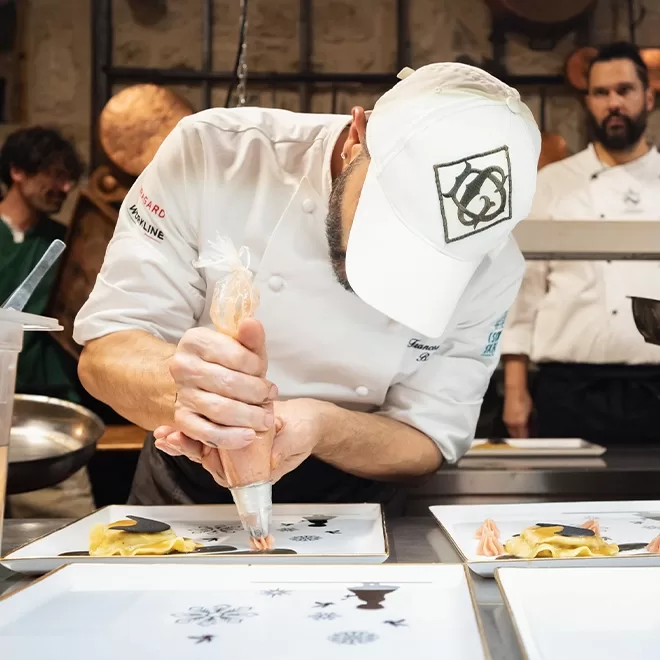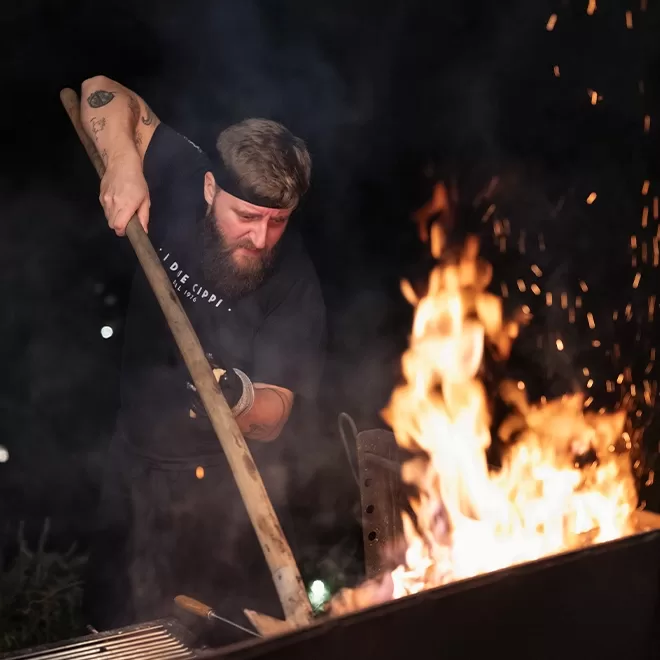‘And over there,’ says Brando, pointing over the stone wall to a vineyard-plaited hill some few hundred metres away, ‘is where we grow our Sangiovese.’
I’m standing on the terrace of Castello di Vicarello on a hazy October morning. Below us, skeins of mist rise like dragon’s breath from the Ombrone river, draping the serrated green hills in a thick white veil. It is quiet and still, the landscape caught in an ancient pause.
The castle feels pulled from a fable. Originally built in the 12th century, the hilltop fortress is now a family-run luxury hotel with 11 sleek suites imagined by a pair of Milanese designers, Carlo and Aurora Baccheschi Berti. Filled with a mix of Indonesian art pieces and family heirlooms, it feels less like a hotel and more like an eclectic home – which is entirely the point. The Baccheschi Bertis raised their three sons – Brando, Neri, and Corso – here, and they all still return every Christmas to celebrate together.
I’m here to test drive Castello di Vicarello’s inaugural Tosco Food & Wine Retreat: three full days of eating, drinking, foraging, and cooking in and around the ancient grounds. Every season, they’ll be teaming up with producers and local restaurants in a natural extension of the hotel’s farm-to-fork ethos. That’s not all. The retreat also promises to provide a deeper connection to Maremma – its landscapes, traditions, and stories – to preserve and share the heritage that enriches this region of Tuscany.
And things started, as they so often do, with wine. Decades ago, Carlo planted seven hectares of high-density, organic vineyards on the castle's hills. On our morning tour of the grounds, eldest son – and now head winemaker – Brando points them out across the valley, before plucking an olive from and rolling it between his fingers, declaring that the recent rains mean it’s not quite ready to press.


Brando leading a wine tasting in the candlelit dining room
It’s been wet here recently – too wet, Neri tells us with a dismayed expression – but that doesn’t impact the quality of the wines. The dense forests and neighbouring Ombrone river create favourable fluctuations in temperature, which, when combined with the clay- and mineral-packed soil and Tyrrhenian Sea breeze, creates an exceptional terroir from which some of Tuscany’s leading wines are produced.
‘Only the most perfect bottles make it,’ says Brando, swirling his glass and inhaling a ruby-red glass of the 2007 vintage. We’re sitting around a long, candelabra-lit table in the main building, a log fire crackling in the corner as Brando leads us through a tasting of the estate’s signature vintages – the first of the many food- and wine-based activities planned for the weekend. ‘But the 2007 is our best vintage of all time.’
All the grapes for each vintage are harvested on the same day, leading to significant variations in flavour: each tells the story of that year’s growing conditions. 2007 was the tale of a dry spring, a rainy June, and a blazing July and August, which led to dense, ripe tannins and an earthy flavour Brando tells us is the undergrowth. 2012 was much drier, resulting in a fresh, juicy wine that won a Great Gold Medal at the Concours Mondial de Bruxelles.


Onion soup (L) | Francesco Bracali in the kitchen
The tasting flows into dinner, which that evening is a four-hands collaboration with Bracali – a Michelin-starred restaurant about 60km away. Francesco Bracali himself appears in between each course to tell us exactly what – and where – we’re eating, which includes an onion soup made using one ingredient but yielding a megamix of textures; a plate of 20 vegetables harvested from the hotel’s gardens that morning; and a single raviolo stuffed with Siena pork aptly named ‘dream of an autumn night.’
Lulled into drowsiness by the flickering of the fire, the bantering of the brothers, and the clinking of wine glasses, I climb the stone steps up to my suite (Vicario – where the Knights Templar lived in the 12th century), climb into my elevated bed, and briefly register that someone has placed a sprig of rosemary on my pillow and a cookie on my bedside table. As I drift off, I’m convinced I hear the screech of a wild boar echoing through the valley.


Youngest brother Corso stoking the fire (L) | The Buriano Estate, where wild ponies and boars live side by side (R)
The next morning, after a belt-stretching breakfast, we roll out to the Buriano Estate – 7,000 hectares of boar-torn hunting land about 50 minutes from the hotel. Here, we meet the third – and youngest – brother, Corso, striding towards us through plumes of smoke curling from an open kitchen, a hunting knife swinging from his belt.
‘Welcome to the wild part of Tuscany,’ he says, stretching his arms wide and looking around at the thick forest around us. ‘I basically grew up in these woods.’
That much quickly becomes obvious. Corso, clutching a piece of cork like a shield, picks over lichen-lashed branches and moss-covered stones with the grace of a dancer, the rest of us squelching behind and squinting to spot the Chanterelle mushrooms we’re hunting for. Wild boars regularly bulldoze through here, slashing the grounds with their tusks and, Corso tells us, taking a dip in what he calls ‘the wild boar spa’ – a water-filled crevice the colour of camomile tea.


Corso, Brando, and Neri (L) | Hunting for Chantarelle mushrooms (R)
‘Have you seen a wild boar recently?’ I ask Corso, wading over a particularly muddy patch of ground and wishing I’d taken the brothers up on their offer of hiking boots.
‘There is not much difference between boars and my brother,’ shot back Neri, smirking as he sidesteps over the same patch, before telling me a story about a particularly dog-like boar that met a rather unfortunate end on one of Corso’s hunts.
Corso has been taking guests out here for the last five years and is clearly itching to share every element of the woods he grew up running wild in, from how to hunt boar to which mushrooms you can pick – and when.
‘It’s about being aware of where you get nourishment from,’ he says. ‘I’ve even had some vegans come here and end up wanting to try the meat. When they hear the story behind it and know how to prepare it, cure it, and treat it, their perspective changes. This is tradition, you know.’


Smoked wild boar and charred vegetables in the forest
We sit down for an alfresco lunch amongst the trees, the smoke from the fire gently billowing across the leaf-laden long table. We eat smoked boar and charred vegetables; thick smoked bacon still sizzling from the flames; and figatelli – a kind of Italian sausage made from pork liver that Neri declares ‘life-changing’. Once our plates are cleared, we look up to see a pair of wild ponies cantering across the field, their manes glimmering in the late October sun.
Back at the castle, the evening passes in a blur. Mediterranean sours on the terrace with Uva standing guard. Neri, leaning back and taking a deep gulp of the starlit air, saying ‘this is the real Castello’. Brando teaching me to swirl my wine like an Italian and telling tales of a magical thermal spring in the forest. Caramelized pear from their mother’s cookbook and salt-baked sea bass. Lavender sprigs and linguine. Sangiovese and stargazing.


Hunting for truffles along an ancient salt path
Sunday dawns. The October sun, hazy as a dream, sprays the ramparts with honey-hued rays. Next to a crumbling archway, a curly-haired, long-legged visitor is leaning against a grey-haired man with a shovel slung over his shoulders like a guitar. This is Arturo, the truffle-hunting dog, accompanied by owner Gianio and his teenage son Julio, who live in the next farm over.
‘Right now is the season for the best type of truffle,’ says Gianio in Italian as we set off down the hill, Arturo at our heels and baskets in hand. ‘Today we’re looking for the black kind – let’s see if we get lucky.’
Arturo leaps ahead through clouds of wild mint and along an ancient path towards the woods that Neri tells us used to be where carriages approached the castle a few hundred years ago. Gianio seizes each truffle he finds, explaining that the bond between man and dog is essential to successful truffle hunting – something he is teaching his son as the next family truffle hunter. We, on the other hand, are tasked with finding more Chantarelle mushrooms for that afternoon’s cooking class – which, it turns out, is blissfully easy.


Bringing up posies of mushrooms from the forest floor
The forest floor glimmers with clusters of mustard-coloured mushrooms, scattered like treasure beneath the trees. Arturo dives and digs as we dip and duck, bringing up posies of mushrooms and occasionally cheering on the little dog as he sniffs out another golf ball-sized black truffle.
‘The forest is full of beautiful things,’ says Neri, passing it around for us to smell.
‘Delicious things,’ corrects Corso as he bends down to add another handful of mushrooms to the basket.
We bring our overflowing baskets back to the castle’s kitchen, where we meet head chef Massimiliano Volonterio – a pony-tailed, tall man who looks like a rockstar. He soon has us brushing off dirt and peeling the mushrooms into bite-sized pieces whilst an Italian tenor (‘my favourite,’ sighs Neri, hand on heart) warbles over the sound system.


A cooking class with head chef Massimiliano Volonterio (R)
‘Cooking is like telling a story,’ says Massimiliano, stirring a risotto on the hob. ‘You have a protagonist you need to bring out on the plate – here, it is the mushroom.’
It’s the kind of philosophical chef talk that prompts me to look for the story of this meal; how the forest feeds the table, and the table feeds the Tuscan traditions that the brothers are so keen to pass on. And then I get distracted stirring cheese and stretching pasta before joining everyone at a long table under the vines where we indulge in yet another long, wine-filled lunch. Tradition indeed.
The afternoon sun swings low, sneaking through the vines before dropping behind the hill and being replaced by the moon. There’s a glow on the terrace – a steak-scented, fiery glow that’s manned by the bearded chefs of Italy’s best steakhouse, I Due Cippi, who are here to grill up our final four-hands dinner.


I Due Cippi stoking the grill (L) | The last supper (R)
As far as closing chapters go, it’s pretty stellar. We sit around the table until long after midnight, all 20 of us laughing like family as we get through eight sublime courses – including an impossibly tender filet steak cooked Tuscan-style for 90 minutes on an open-air grill. As the brothers raise their glasses in a toast to the retreat, I’m gripped with a sense that the weekend wasn’t just about wine or pasta or Michelin-starred chefs. This was about tradition – stories, places, techniques, and recipes passed down from generation to generation.
Finally, I sit alone at the antique writing desk in my suite. The moonlight spills through the open shutters and the soft hum of voices drifts in with the night air. In this castle, the Baccheschi Berti family has brought Tuscany to life – its wine, its landscapes, its traditions, its stories. And I pick up my pen and begin to write.


















